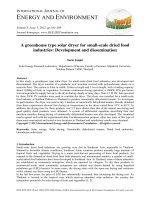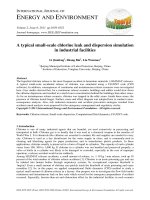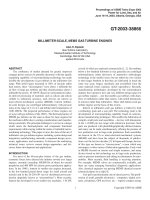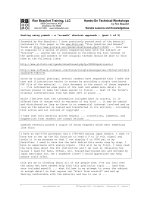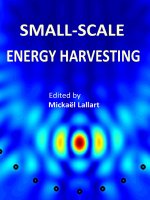- Trang chủ >>
- Khoa Học Tự Nhiên >>
- Vật lý
Scale invariance
Bạn đang xem bản rút gọn của tài liệu. Xem và tải ngay bản đầy đủ của tài liệu tại đây (3.21 MB, 301 trang )
www.pdfgrip.com
www.pdfgrip.com
Richard N. Henriksen
Scale Invariance
www.pdfgrip.com
Related Titles
Wolf, J.P.
Logan, J.
The Scaled Boundary Finite
Element Method
Applied Mathematics, Fourth
Edition
2003
Print ISBN: 978-0-471-48682-4
Adobe PDF ISBN: 978-0-470-86148-6
Fourth Edition
2013
Print ISBN: 978-1-118-47580-5,
also available in digital formats
Krantz, W.B.
Scaling Analysis in Modeling
Transport and Reaction
Processes
A Systematic Approach to Model
Building and the Art of Approximation
2007
Print ISBN: 978-0-471-77261-3,
also available in digital formats
Abry, P., Goncalves, P., Vehel, J. (eds.)
Scaling, Fractals and Wavelets
2008
Print ISBN: 978-1-848-21072-1,
also available in digital formats
www.pdfgrip.com
Richard N. Henriksen
Scale Invariance
Self-Similarity of the Physical World
www.pdfgrip.com
Author
Richard N. Henriksen
Queen’s University
Department of Physics
Engineering Physics and Astronomy
Kingston, ON
Canada
All books published by Wiley-VCH are
carefully produced. Nevertheless, authors,
editors, and publisher do not warrant the
information contained in these books,
including this book, to be free of errors.
Readers are advised to keep in mind that
statements, data, illustrations, procedural
details or other items may inadvertently
be inaccurate.
Library of Congress Card No.: applied for
British Library Cataloguing-in-Publication
Data
A catalogue record for this book is
available from the British Library.
Bibliographic information published by the
Deutsche Nationalbibliothek
The Deutsche Nationalbibliothek
lists this publication in the Deutsche
Nationalbibliografie; detailed
bibliographic data are available on the
Internet at <>.
© 2015 Wiley-VCH Verlag GmbH & Co.
KGaA, Boschstr. 12, 69469 Weinheim,
Germany
All rights reserved (including those of
translation into other languages). No part
of this book may be reproduced in any
form – by photoprinting, microfilm,
or any other means – nor transmitted
or translated into a machine language
without written permission from the
publishers. Registered names, trademarks,
etc. used in this book, even when not
specifically marked as such, are not to be
considered unprotected by law.
Print ISBN: 978-3-527-41335-5
ePDF ISBN: 978-3-527-68733-6
ePub ISBN: 978-3-527-68735-0
Mobi ISBN: 978-3-527-68736-7
oBook ISBN: 978-3-527-68734-3
Typesetting Laserwords Private Limited,
Chennai, India
Printing and Binding Markono Print
Media Pte Ltd., Singapore
Printed on acid-free paper
www.pdfgrip.com
V
To colleagues past, Judith,
my parents and my children
www.pdfgrip.com
www.pdfgrip.com
VII
Contents
Preface XI
Acknowledgments XIII
Introduction XV
1
1.1
1.2
1.3
1.4
1.4.1
1.4.2
1.4.3
1.4.4
1.4.5
1.4.6
1.4.7
1.4.8
1.4.9
1.4.10
1.4.11
1.4.12
2
2.1
2.1.1
2.1.2
2.1.3
2.1.4
2.2
2.2.1
2.2.2
2.3
Arbitrary Measures of the Physical World 1
Similarity 1
Dimensional Similarity 3
Physical Equations and the ‘Pi’ Theorem 6
Applications of the Pi Theorem 10
Plane Pendulum 11
Pipe Flow of a Fluid 16
Steady Motion of a Rigid Object in Viscous ‘Fluid’
Diffusion and Self-Similarity 20
Ship Wave Drag 26
Adiabatic Gas Flow 28
Time-Dependent Adiabatic Flow 30
Point Explosion in a Gaseous Medium 33
Applications in Fundamental Physics 35
Drag on a Flexible Object in Steady Motion 41
Dimensional Analysis of Mammals 42
Trees 47
References 51
18
Lie Groups and Scaling Symmetry 53
The Rescaling Group 53
Rescaling Physical Objects 55
Reconciliation with the Buckingham Pi Theorem 59
Rescaling and Self-Similarity as a Lie Algebra 60
Practical Lie Self-Similarity 63
Familiar Physical Examples 68
Line Vortex Diffusion: Reprise 69
Burgers’ Equation 71
Less Familiar Examples 77
www.pdfgrip.com
VIII
Contents
2.3.1
Self-Gravitating Collisionless Particles: The Boltzmann-Poisson
Problem 77
References 84
3
Poincaré Group Plus Rescaling Group
3.1
3.2
3.2.1
3.2.2
3.3
Galilean Space-Time 87
Minkowski Space-Time 96
Self-Similar Lorentz Boost 96
Self-Similar Boost/Rotation 102
Kinematic General Relativity 108
References 119
4
Instructive Classic Problems 121
4.1
4.2
Introduction 121
Ideal Fluid Flow Past a Wedge: Self-Similarity of the ‘Second
Kind’ 121
Boundary Layer on a Flat Plate: the Blasius Problem 126
Adiabatic Self-Similarity in the Diffusion Equation 133
Waves in a Uniformly Rotating Fluid 140
References 146
4.3
4.4
4.5
5
5.1
5.1.1
5.1.2
5.1.3
5.2
5.2.1
5.2.2
5.2.3
5.3
5.3.1
5.3.2
6
6.1
6.1.1
6.2
6.3
6.3.1
87
Variations on Lie Self-Similarity 147
Variations on the Boltzmann–Poisson System 147
Infinite Self-Gravitating Collisionless Spheres 147
Finite Self-Gravitating Collisionless Spheres 155
Other Approaches to Finite Spheres 159
Hydrodynamic Examples 164
General Navier–Stokes Theory 164
Modified Couette Flow 166
Flow at Large Scale inside a Laminar Wake 170
Axi-Symmetric Ideal Magnetohydrodynamics 178
Incomplete Self-Similarity as Separable Multi-variable
Self-Similarity 182
Isothermal Collapse 185
References 187
Explorations 189
Anisotropic Self-Similarity 189
Anisotropic Similarity 192
Mathematical Variations 193
Periodicity and Similarity 198
Log Periodicity and Self-Similarity: Diffusion
Equation 203
References 207
www.pdfgrip.com
Contents
7.1
7.1.1
7.1.2
7.1.3
Renormalization Group and Noether Invariants 209
Hybrid Lie Self-Similarity/Renormalization Group 209
Renormalizing More Complicated Equations 216
Schrödinger: Adiabatic and Fractal 219
Noether Invariants and Self-Similarity 223
References 229
8
Scaling in Hydrodynamical Turbulence 231
8.1
8.2
8.2.1
8.2.2
8.3
8.4
8.4.1
8.4.2
General Introduction 231
Homogeneous, Isotropic, Decaying Turbulence 232
Third-Order Correlation Negligible 236
Renormalization and Homogeneous, Isotropic, Turbulence 240
Dimensional Phenomenology of Stationary Turbulence 242
Structure in 2D Turbulence 246
Similarity of Time-Dependent 2D Vortical Fluid Flow 248
Similarity in Physically Steady, Inviscid Vortical Fluid Flow 258
References 264
7
Epilogue 267
Appendix: Examples from the literature 269
Index 273
IX
www.pdfgrip.com
www.pdfgrip.com
XI
Preface
This book attempts to reconcile a physical understanding of Similarity, SelfSimilarity and Scale Invariance with a more formal mathematical description.
The latter treatment is implicit in the analysis of differential equations by Lie
groups, but here that method is tailored to address more physical problems in an
original manner.
The book begins with an extensive presentation of the physical formulation
based on Unit invariance. Subsequently, it presents the more mathematical Lie
algebra formulation and compares the two methods through physical examples.
The Lie algebra method advocated in the book is not restricted to reproducing
results found by conventional analyses. It emphasizes that the invariants associated with the rescaling symmetry are the physical content. Moreover, the Lie
method is shown to lead to generalizations such as the complete symmetry in conjunction with the Rotation and Translation groups, a technique for coarse graining, anisotropic rescaling, and useful contact with the Renormalization group. The
book also demonstrates a novel treatment of scaling symmetry in Special and
General Relativity. Familiar complications such as multi-variable Self-Similarity
and Self-Similarity of the ‘second kind’ are readily treated and clarified through
examples.
The actual application of these symmetries in the literature has been of
incomparable importance in building intuition about myriad physical situations.
A legion of authors has contributed. This book is ultimately a credit to these
authors. In the appendix, a mere sampling of the ingenuity of these works is
listed.
Kingston, Ontario
October 2014
Richard N. Henriksen
www.pdfgrip.com
www.pdfgrip.com
XIII
Acknowledgments
Much of what I understand of Scale Invariance has been learned from astrophysical colleagues. The ingenuity exercised in myriad studies is inspiring. Students
have been tolerant. My wife Judith never fails to contribute, encourage and love.
www.pdfgrip.com
www.pdfgrip.com
XV
Introduction
The real voyage of discovery consists not in seeking new lands but seeing with
new eyes - Marcel Proust
This book is a compendium of Dimensional analysis techniques elaborated both
formally and through examples. The examples include elementary illustrations,
and are also meant to reveal what this analysis can do for advanced and important
current problems. It is difficult for one person to treat examples from all possible
disciplines. The examples chosen are, when rigorous, mainly from hydrodynamics, astrophysics and relativity. One hopes that the techniques developed are more
universal. In this Introduction, we try to list the objectives and the accomplishments of each chapter, in order that the reader may have more than an index from
which to choose.
Chapter 1 is based on a classical theorem, usually attributed to Buckingham.
It discusses the reason for the importance of Dimensional analysis and gives a
simple intuitive proof of the theorem. Unlike some other treatments, great stress
is placed on forming an accurate ‘catalogue’ of physical quantities that affect a
system’s behaviour. This disciplined step is essential to obtaining accurate conclusions, and it generally requires substantial physical insight.
Examples in this chapter are taken from engineering fluid problems such as pipe
flow (even from the Canadian tar sands or a micrometeorite puncture in a space
suit) and flow past rigid bodies. The latter flow allows the introduction of Similarity symmetry between separate systems. Diffusion of vorticity is used to introduce
Self-Similarity in a single system. Examples include illustrations from fundamental physics plus speculation (in the spirit of Dimensional analysis) on the metabolic
rate variation between mammals. We also use the combined ‘catalogue theorem’
analysis to discuss the drag reduction in the flow past flexible bodies and ponder
Leonardo’s observation about trees.
Chapter 2 presents the Lie theory approach introduced by Carter and Henriksen (see Ref. [1] in Chapter 2) in the context of Similarity and Self-Similarity. This
is a more algorithmic, algebraic, approach than that of Chapter 1. It is important
to realize that although most of the results can be obtained in other ways, they
normally require more subtle argument than does this algorithmic approach. This
technique allows all possible rescaling symmetries to be readily identified, and it
www.pdfgrip.com
XVI
Introduction
can be used (see subsequent chapters) to generalize the usual Self-Similar Rescaling group to include the Poincaré/Galilean group. The Lie algebra affords a useful
classification of Similarity and Self-Similarity in terms of a Self-Similarity classification. The ‘class’ is the ratio of temporal to spatial rescaling.
The first two sections of Chapter 2 give the mathematical foundations. They are a
sub-set of the Lie group method for solving differential equations (e.g. Bluman and
Cole, see Ref. [2] in Chapter 2). The novelty is to introduce Dimensional covectors
into the rescaling algebra. All of the conventional Dimensional analysis is hidden
in the calculation of these vectors for each physical quantity (including the base
manifold of space-time in relativity).
Once these Dimensional covectors are obtained, the variation of any physical
object along the ‘direction’ (in base Dimension space) imposed by the Lie SelfSimilar algebra may be calculated. The corresponding physical invariants along
the symmetry direction are then readily found. This practical simplicity is due to
the Lie derivative taking a very simple form, when these invariants are used as the
description of the set of physical objects. The set of invariant functions and the
relation between them is the generalization of the typical Universal function of a
Self-Similar variable (equal here to the Lie group path parameter), which contains
the physical essence of a system.
We proceed first by illustrative elementary examples, which in some cases
re-work problems of Chapter 1. However, gradually novel applications are
introduced. These include a Self-Similar solution of the Schrödinger equation and
an introduction to the Self-Similar Symmetry of Burgers equation. Multi-variable
Self-Similarity is introduced in the context of the Boltzmann–Poisson (or
Vlasov–Poisson) collisionless, self-gravitating, spherical system.
In these introductory two chapters, presenting the two techniques of Dimensional analysis is the principal goal. The results found in the various applications
are less authoritative, being principally an examination of one or the other technique in action. Despite sometimes being speculative, they may however be inspirational to the receptive mind.
In Chapter 3, the most general symmetry group of Galilean space-time is
discussed with the Lie method, which requires adding the Rescaling group
action to that of the Poincaré/Galilean group. In parallel with the analysis of the
Poincaré Rescaling group in Galilean space-time, we have extended the analysis
to Minkowski space-time. We give a Lie group derivation of the Lorentz boost.
We also take the opportunity to digress briefly from our main objective, in
order to discuss the Lorentz boost as complex rotation in a complex Minkowski
space. This includes the compactification of Minkowski space by stereographic
projection.
The Lie technique allows us to readily examine the Minkowski space Self-Similar
symmetry as a combination of rotation and Lorentz boost. In this manner, we
derive coordinate transformations that express this combined Symmetry. These
formulae include the time dilation formulae in various combined examples.
www.pdfgrip.com
Introduction
Clues from the discussion of Galilean space-time are used to discover a general
type of covariant Self-Similarity in the Riemannian space-time of General Relativity. This Self-Similar symmetry was puzzingly absent for a rather long period,
even after the work of Cahill and Taub (see Ref. [7] in Chapter 3). We refer to the
abstract description of this Symmetry as kinematic Self-Similarity. It exists also in
Galilean space-time.
The more general Self-Similarity in relativistically gravitating matter generalized
the homothetic variety that was introduced by Cahill and Taub. In the special case
of geometrical spherical symmetry, this results in one of the Lie invariants being a
ratio of time to a power of radius. This more general General Relativistic Symmetry corresponds to the general Symmetry known to exist classically. Its previous
apparent absence from General Relativity was the source of the puzzle referred to
above. Here the algorithmic study has produced a result that generalizes what had
been already found by Lynden-Bell and Lemos (see Ref. [10] in Chapter 3).
In order to obtain this result as well as some more elementary cases elsewhere,
we were obliged to introduce the notion of ‘hidden constants’. By choosing Units
appropriately, one can always remove constants that appear explicitly in the physical equations of a system. However, this will not, in general, remove the constraints
that they impose. This is the case when they are essential to the Dimensional
coherence of the governing equations. In the context of a Dimensionally consistent
Lie group Symmetry, this is not always the case. In developing kinematic SelfSimilarity, we used the ability to set c = G = 1, while simultaneously imposing the
new Symmetry through Lie derivatives of the Dimensionally coherent metric.
The algorithmic Dimensional analysis allows us to introduce readily the notion
of ‘running constants’. These are not usually fundamental constants, but are rather
contingent constants, such as a fluid viscosity (including the parameter in Burgers equation), or resistivity in a conducting fluid. However, fundamental coupling
constants in field theory are also ‘running’. There is an evident connection in
this context between the Rescaling group and the Renormalization group that we
explore subsequently.
In Chapter 4, we turn to a collection of more practical problems. These are chosen to illustrate the nuances that arise in the application of rescaling symmetry.
Some notions introduced by Barenblatt (see Ref. [2] in Chapter 1) are shown to
be treatable by the Lie method. These include describing Self-Similar solutions
as ‘intermediate asymptotes’ and the notion of Self-Similarity of the ‘second kind’.
We prefer to describe ‘incomplete Self-Similarity’ as multi-variable Self-Similarity,
wherein conservation laws and physical intuition can suggest the form of special
solutions. This is illustrated in the example of a point source of waves in a rotating
medium due to Sobolev.
The unifying concept in all of these examples is the concept of ‘Self-Similarity
class’. We give an example where this class may be considered as adiabatically
varying in response to boundary conditions that are varied adiabatically. This is a
new concept inspired by the Lie technique. This same example indicates numerically how an envelope solution may be a renormalized approximation to a series
of perturbative local solutions.
XVII
www.pdfgrip.com
XVIII
Introduction
Another novel use of Self-Similarity in this chapter is the introduction of
anisotropic ‘classes’. This finds expression in the discussion of the boundary layer
on a flat plate due to Blasius. Not all lengths need be scaled similarly. This leads to
an expanded dimensional algebra vector wherein a given component is particular
to a given spatial dimension. As a practical aside, we are able to suggest analytic
approximations to the Blasius boundary-layer equation.
Chapter 5 is really an extension of the examples in Chapter 4 to more advanced
problems. We begin with a detailed study of an isotropic, spherically symmetric,
collisionless system of particles.
This first example has some scientific interest, but it is used mainly to show
how various Self-Similar classes arise from the same set of equations. There is
a real advantage gained by solving the system with an initially general class. In
particular, the Self-Similar class is sometimes related to the more commonly used
‘polytropic index’, but it also proves to be more general. The polytropes are not in
fact globally Self-Similar. Nevertheless, there is a sense in which they are ‘close’ to
this symmetry, and a Self-Similar class appears asymptotically. The transformed
variables that are the key to our method are themselves both general and easily
made ‘close’ to Self-Similar variables. The use of these variables sometimes allows
the use of Self-similar class when the system is only partially Self-Similar.
A particular detailed example is the ‘Schuster polytrope’. This demonstrates the
novel concept alluded to above in that we are able to study this non-Self-Similar
system by using the class concept to remain ‘close’ to Self-Similar symmetry in
the group-based variables. The Schuster and the corresponding Self-Similar distribution functions share the same dependence on energy, but the potential differs
essentially. Our method gives an unusual form for the Schuster polytrope, which
has the virtue that it is easy to verify.
The preceding globally Self-Similar systems are all infinite spheres. The question
also treated in this extended discussion is ‘can Self-Similar symmetry be present in
finite spheres?’ We show this to be possible by taking the limit of vanishing spatial
scaling, that is infinite Self-Similar class. This yields the polytrope with index unity,
but with a non-Self-Similar potential. This argument introduces the concept of
‘running’ rescaling algebra components, which is much used subsequently.
The polytropes may be proved to be asymptotically Self-Similar by pursuing the
other ‘running’ extreme of infinite spatial scale, that is zero Self-Similar class. This
only applies for the polytropes that extend to infinity with infinite mass, but in
these cases the asymptotic potential is correctly found. This essentially introduces
the idea of a power series solution in powers of the reciprocal scale. This procedure
proves useful in later examples and represents a novel kind of ‘coarse graining’. All
of this is accomplished by remaining ‘close’ to Self-Similarity through the use of
suitably Lie group-based coordinates and variables.
The final study of the finite collisionless sphere is used as an example of Pi
theorem Renormalization. We use the Units freedom as a way of quantitatively
renormalizing the equations. This leads to a power series approximation to the
system. It represents in one case the power law solution of the isothermal sphere,
as was found by Chandrasekhar (see Ref. [3] in Chapter 5) using other methods.
www.pdfgrip.com
Introduction
It turns out to be an example of a development that is exterior to the Lie algebra
approach to Self-Similarity.
We turn finally in this chapter to hydrodynamic examples. Couette flow is used
to show the effect of a variable viscosity. This viscosity is an example of a running
constant. The only true Self-Similar flow without time-dependent boundaries is
in fact the steady state. The more general Self-Similar Symmetry in the Couette
geometry is restricted to expanding or contracting cylindrical waves.
Perhaps the most important example studied in this chapter is that of the steady,
laminar wake, at large distance behind an arbitrarily shaped body. We show that
such a wake can be studied algorithmically as another example of anisotropic
Self-Similarity. Once this is applied systematically, all standard results (given for
example in the text by Landau and Lifshitz) are recovered.
We are able to apply our method to study the time dependence of such a wake
while retaining Self-Similar Symmetry. The solution is given in a power series in
powers of a reciprocal spatial scale. This is small at large scales. The expansion
does not converge in time so that it is only locally valid. This situation is exactly
that which may be treated by the envelope renormalization scheme. We apply this
procedure to show that one can find a convergent global solution in this way. The
wake is found to decay on a convection timescale.
Chapter 6 begins with the formal discussion of anisotropic spatial scaling.
Ultimately this is described by generalizing the rescaling algebra component 𝛿
to a strain tensor 𝛿. A brief discussion of the generation of distinct, but Similar,
anisotropic structures is also given.
A following major section of this chapter compares the more formal mathematical technique of solving partial differential equations using Lie Symmetry
‘generators’ and the technique advocated in this book. This is done in some detail
in the context of the Liouville equation. Some well-known simple solutions are
re-derived.
The chapter continues with a discussion of discrete Self-Similarity as illustrated
by periodic systems. We find that this notion corresponds to complexifying the
rescaling algebra. The harmonic, Mathieu, diffusion and wave equations are used
as examples.
Chapter 7 addresses the relation between Self-Similar Symmetry and the iterative Renormalization group. We show that the two techniques may be combined to
suggest a hybrid Self-Similar/Renormalization group. The idea requires additional
exploration and numerical demonstration. However, an abbreviated procedure
following Sedov (see Ref. [4] in Chapter 1) is introduced in Chapter 8. The ideas
are used to derive the fractal path of a free quantum particle using the Schrödinger
equation.
The second part of this chapter compares Self-Similarity with Noether symmetry in the context of Lagrangian mechanics. The Noether conserved quantities
are demonstrated to be more general than Self-Similar scale invariance and allow
more general solution types. In particular, the Noether integrals exist in conservative systems where a Dimensional constant exists independently of the energy.
XIX
www.pdfgrip.com
XX
Introduction
Ab initio Dimensional Self-similarity is ambiguous in such cases unless appropriate limits are taken.
The ultimate Chapter 8 attempts an overview of the use of scale invariance in
turbulence theory. Due respect is paid to the appearance of broken Self-Similarity
in higher order structure functions, although no serious solution is offered. Much
of the discussion is confined to the second- and third-order structure or correlation functions, where the Rescaling Symmetry is at least approximate. The
Lie group analysis is based on the von Karman–Howarth equation. Attempts are
made to re-derive both the Kolmogorov second-order velocity scaling and the
third-order ‘four fifths’ law. In some derivations of standard phenomenology, the
Buckingham method is the most readily used.
The major novelty is to use the extended Lie Symmetry group to study possible structures in 2D turbulence. We generate these as similar structures that are
rescaled, rotated and translated. This is achieved starting from a reference solution given in terms of invariant coordinates, whose transformation from original
Cartesian coordinates is known at each point on the Lie group path. The reference solution is then stepped along the Lie group path, and a similar solution in
Cartesian coordinates is constructed there using the coordinate transformations.
In this way, an ensemble of similar structures may be generated. A simple example
of only one step is given.
Interaction of the structures in the ensemble must be added separately. If each
structure is bounded, we might treat the system as an interacting ensemble of line
vortices as an approximate description of the global behaviour. Internally, each
vortex will have the same structure. If however each similar flow extends to infinity, then the interaction will be of a ‘sweeping’ kind. That is the motion generated
at a neighbouring vortex by a larger and stronger vortex will be convection due to
the larger flow. These ideas require elaboration in subsequent work.
www.pdfgrip.com
1
1
Arbitrary Measures of the Physical World
Abusus non tollit usum (Abuse does not exclude use).
1.1
Similarity
It is worth recalling the intuitive notion of Similarity before we begin. We learn
about similar triangles in school. Such triangles can be displaced, rotated and
dilated (positively or negatively) in order to achieve congruence and thereby be
reduced to congruent identity. The dilation is restricted so that each side of the triangle is multiplied by the same factor. This geometric operation can be expressed
algebraically by appealing to the theorem of Pythagoras.
In a right-angled triangle of sides {a, b, c}, the Pythagorean theorem gives the
largest side c as c2 = a2 + b2 . Any other right-angled triangle {a′ , b′ , c′ } is similar
to the first triangle in the geometric sense if each side is related to the corresponding side by the same numerical factor. These similar right-angled triangles are said
to have the same ‘shape’, independent of rescaling, rotation or translation. This
imprecise notion may be henceforth defined operationally as an invariant, subject
to these various operations. That is, the ‘shape’ of a right-angled triangle is contained algebraically in the invariance of the Pythagorean theorem under a uniform
scale change, plus rigid rotations and displacements.
More complicated geometrical structures also have a ‘shape’ invariant under
operations appropriate to their form. A general triangle {a, b, c} satisfies the
‘cosine law’ in the form c2 = a2 + b2 − 2𝑎𝑏 cos 𝜃, if 𝜃 is the angle included between
the sides {a, b}. The labelling of the sides is arbitrary so that this law holds for
any side in terms of the other two sides and their included angle (a triangle is a
zero sum of three vectors and the included angle is interior between two sides).
The expression remains true under the same rescaling of all the sides for a given
angle. Hence, the shape is invariant under the same operations as above once
Scale Invariance: Self-Similarity of the Physical World, First Edition. Richard N. Henriksen.
© 2015 Wiley-VCH Verlag GmbH & Co. KGaA. Published 2015 by Wiley-VCH Verlag GmbH & Co. KGaA.
www.pdfgrip.com
2
1 Arbitrary Measures of the Physical World
three sides, or one side and two angles, are specified at any given scale (the sine
law helps here).
In analytic geometry, examples abound. If {x, y} are the Cartesian coordinates
of a point on an ellipse of major axis 2a and minor axis 2b, then x2 ∕a2 + y2 ∕b2 = 1.
The origin is evidently at the centre of the ellipse. An ellipse has the ‘shape’ invariant in its new form x′ 2 ∕a′ 2 + y′ 2 ∕b′ 2 = 1, if a′ ∕a = b′ ∕b. That is, once again the
invariance is under a uniform spatial rescaling in addition to rigidity.
In all of these geometric examples, the scaling factor might be a function of time,
which implies that the sides are ‘rubberized’. In this case, the shape invariance
would be between differently expanded (or contracted) versions of the original
figure rather than between different figures. In addition, there might be a rigid
rotation of the figure, but in any case it would remain similar to itself. This kind of
shape invariance is referred to as ‘Self-Similar’.
For example, if the sides of a triangle were to be expanded in time according to
the power law tp , then we could write
𝜉a ≡
a
a
= po ,
tp
to
𝜉b ≡
b
b
= po ,
tp
to
𝜉c ≡
c
c
= po ,
tp
to
(1.1)
where the subscript o denotes initial quantities, and p is any real number. The
important observation is that the variables on the left side are invariants under
the stretching operation. These invariants are normally referred to, somewhat
paradoxically, as ‘Self-Similar variables’. This is because the essence of the triangle’s geometry can be expressed as invariant relations between these quantities.
A series of such triangles would require variable invariants for its description.
The Symmetry in question lies in the structure of these variables, while the
physical structure lies in the invariant relations between them. Thus, the essential
structure of a growing or shrinking right-angled triangle becomes for all time
𝜉a2 + 𝜉b2 = 𝜉c2 .
(1.2)
It should be evident from the preceding discussion that the reason we try to
define the ‘shape’ invariance is that it establishes a large class of figures. Because of
the invariance, we need to study the shape of only one example of the class. In fact,
once the numerical operations that establish identity are defined, they become
themselves the quantitative measure of ‘shape’. The operations replace the vaguer
notion of the invariant shape and become the subject of study. Operations such as
scaling, displacement and rotation together with appropriate elements on which
they act form a mathematical object known as a ‘group’.
It becomes clear that there is a route by which the notion of similarity can be
greatly generalized. One may define physical systems and structures as ‘similar’
if they can be brought into coincidence or ‘identity’ by the action of some group
of operations on their elements. Systems that vary in time may also be brought
into coincidence with themselves by an appropriate group of operations. In this
instance, the system is said to be ‘self-similar’ at all times.
The more general the group that achieves identity, the more abstract is the corresponding invariant behaviour. Rather than the elementary geometrical ‘shape’,
www.pdfgrip.com
1.2
Dimensional Similarity
we will soon meet systems in which several invariant numbers characterize the
identity or symmetry. These become the ‘Pi’ quantities that occupy us in the major
part of this chapter. The group of interest in this chapter is the consistent rescaling
of physical quantities that have Dimensions, by the arbitrary choice of Units. It is
a kind of renormalization of physical quantities (see e.g. Chapter 5), but we refer
to it simply as either the Dimensional Similarity group1) , or more simply as the
Rescaling group.
As at least a first step in grasping a system intuitively, one finds applications of
Similarity in many diverse areas. Some problems such as those found in physics
or chemistry are governed by equations. These aid greatly in the formulation of
the Dimensional Similarity group, and, in turn, the equations can be simplified by
the application of this group. In other areas such as Economic theory, Biological
theory or observational Astronomy, the governing equations may not be available.
In this case, the formulation of the invariants of the Dimensional Similarity group
may be all that is easily obtained theoretically.
1.2
Dimensional Similarity
In this section, we introduce Dimensional analysis and Similarity with an engineering flavour, although we also experiment briefly with biological and fundamental systems. We use ‘Dimension’ with a capital letter to signify a measurable
property of the world. Examples of ‘pure’ Dimensions are Time, Space, Mass and
Temperature. Combinations of these are also found, as for example in velocity,
energy or angular momentum. Frequently, the first three quantities listed are sufficient to constitute a complete basis of Dimensions for mechanical purposes. That
is, all other mechanical quantities have Dimensions expressible in terms of the
basis Dimensions. Economic theory requires that ‘money’ be added as a Dimension of the world, while thermodynamics requires the addition of the temperature
Dimension (unless Boltzmann’s constant is used to convert temperature to energy
and never appears otherwise).
In order to obtain a numerical ‘measure’ of these Dimensions, we introduce a
standard quantity corresponding to each Dimension, which we call a ‘Unit’. Thus,
a numerical value of ‘duration’, being the extent of the time Dimension, is simply a
number of standard temporal units such as Seconds, Days, Years or Centuries.
‘Second’ is now measured in terms of the oscillation frequency of a hyperfine
atomic energy level of Cesium (133), and the most precise measures of Time are
made by these atomic ‘clocks’.
A quantity of inertial mass might be some number of Grains, Grams, Kilograms,
Metric Tons or indeed Solar Masses associated with the object. Because of the
omnipresence of a (nearly) constant gravitational acceleration g at the surface of
the Earth, we usually measure Mass in terms of ‘Weight’ that we obtain formally
1) The use of capitals here is explained in the next section and applies throughout the chapter.
3


